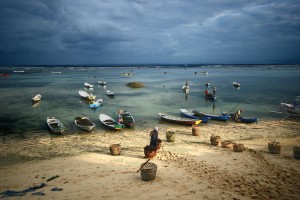Seaweed Farming: Bringing Sustainability to Coastal Environments and Communities
by Erick Ask, Seaweed Development, FMC BioPolymer
May 10, 2013
 Coastal communities in developing countries face numerous challenges. Rising populations continue to put more pressure on coastal ecosystems, leading to decreased fish stocks, habitat destruction and pollution. Lack of access to quality education makes it difficult for the children of these communities to pursue more lucrative, non-traditional jobs in growing sectors of the economy. And parents, faced with decreasing fish stocks, lack money to improve housing, nutrition and other aspects of a quality life.
Coastal communities in developing countries face numerous challenges. Rising populations continue to put more pressure on coastal ecosystems, leading to decreased fish stocks, habitat destruction and pollution. Lack of access to quality education makes it difficult for the children of these communities to pursue more lucrative, non-traditional jobs in growing sectors of the economy. And parents, faced with decreasing fish stocks, lack money to improve housing, nutrition and other aspects of a quality life.
Certainly governments, NGOs, academe, the private sector and the residents themselves are very aware of the challenges these coastal communities face. They realize the solutions are multifaceted, involving the development of a sustainable economy based on investing in infrastructure (roads, power, communications, etc.), supporting education, assuring good governance and the rule of law, and developing sustainable management plans for the natural resources. During the last 30 years, the concept of Integrated Coastal Zone Management has been developed, along with Marine Parks and Marine Protected Areas. These are ways for coastal communities to take ownership of their resources and developing sustainable management plans where they see the financial benefit of maintaining healthy ecosystems.
The tropical Eucheumoid seaweed farming industry, which was invented by FMC-Marine Colloids in partnership with the University of Hawaii and the Philippines Bureau of Fisheries and Aquatic Resources in the late 1960’s, has observed with interest this growing awareness of coastal degradation and desire for resource management. The industry itself has been offered as a case study in how to develop sustainable alternative livelihoods that protect the environment, provide economic growth, allow for sustainable resource management and create a brighter future for coastal communities.
There are a few keys to success. Sustainable, alternative livelihoods must offer a guaranteed market, an attractive price for the product and low capital and operating costs. They must be based on native species and require simple, basic knowledge and skills that are easy to adopt, with material inputs that are readily available. Eucheumoid seaweed farming, along with a few other types of aquaculture based on filter feeders, fits these criteria.
Eucheumoid seaweed farms provide three key environmental services:
- They help consume the excess nutrients from agriculture and urban runoff.
- Farms that are floating or located over barren, sandy bottoms become new habitats for fish and invertebrates, enhancing the ecosystem.
- They are primary production, as farms are food for herbivorous fish and invertebrates, which enhances the ecosystem.
In addition there are two primary socio-environmental services provided by Eucheumoid farming:
- It creates an alternative, sustainable livelihood.
- It develops a stewardship mentality in farmers because their production and income depend on a quality seawater supply.
The seaweed farming industry is proud that production grew from 5,000 tonnes in 1970 to over 200,000 dry tonnes today and that the quality of life of tens of thousands of coastal residents has improved dramatically as hundreds of millions of dollars have flown into these economies from seaweed purchases. However, there is a limit to the demand of seaweed farming and hence a limit to the number of communities that can benefit. So, perhaps the biggest benefit Eucheuma seaweed farming can provide is to act as a role model for all parties interested in protecting coastal environments and seeing coastal communities flourish.
Pingback: Sustainable Seaweed Farming As An Agricultural Model | Blackle Mag
Pingback: Carrageenan: Sustainable Friend to the Environment - Fields of Good
Pingback: Homepage